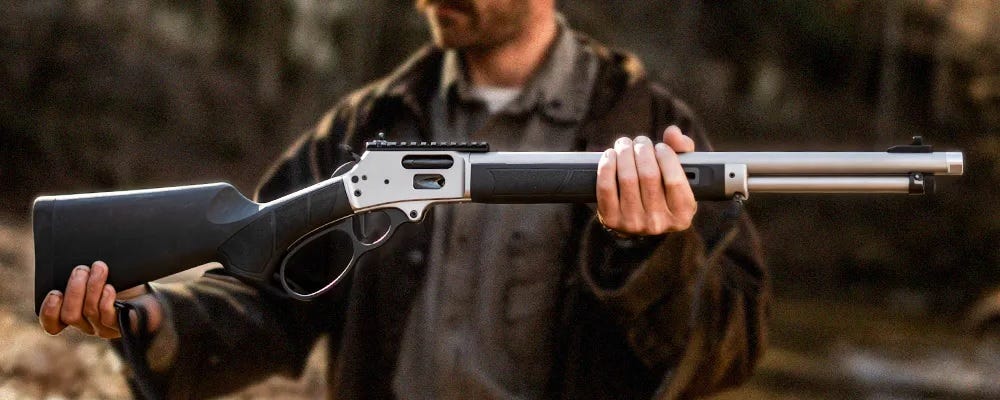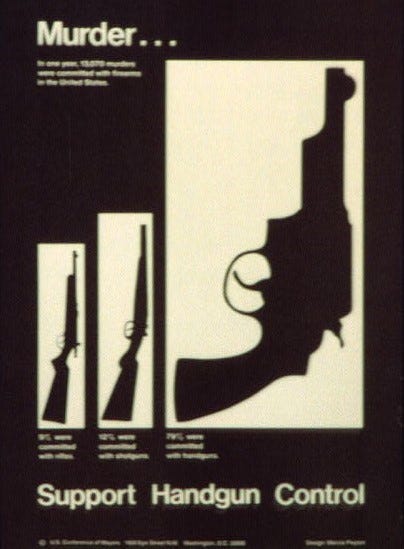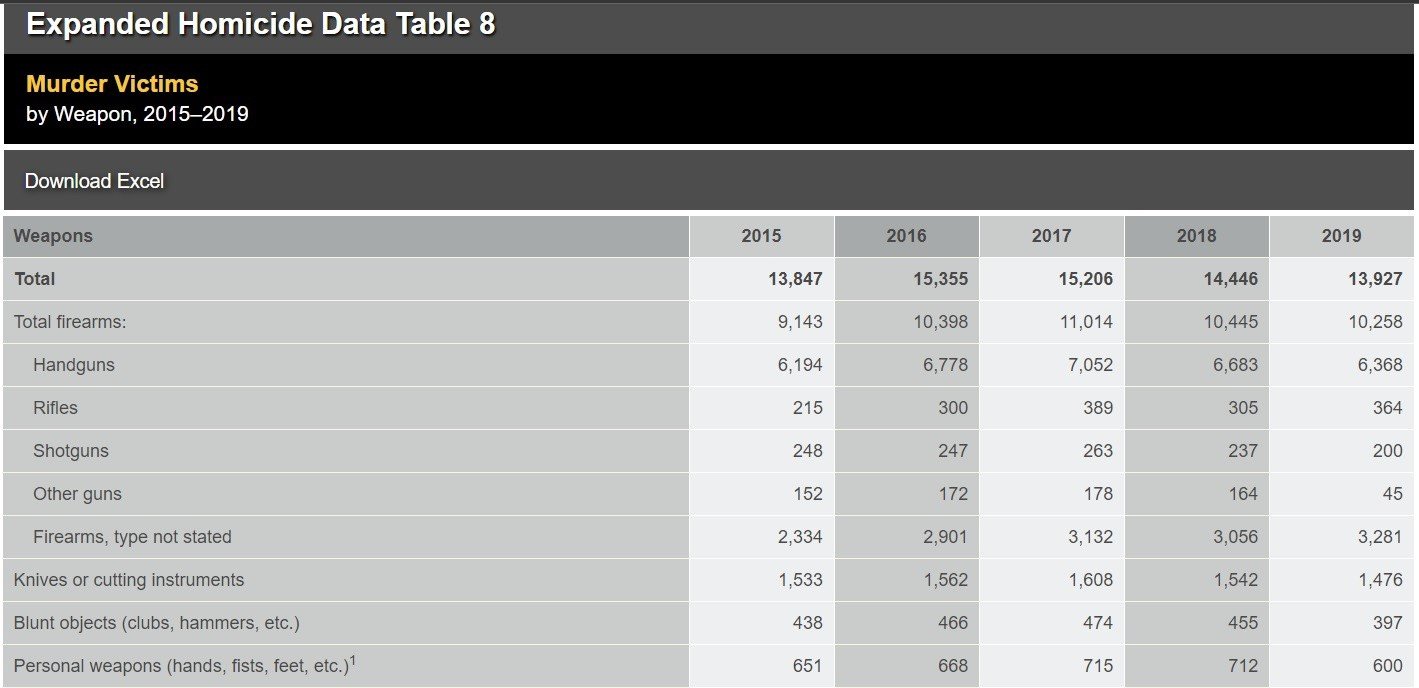The "Assault Weapon" Myth
How gun control organizations deliberately manufactured fear about "assault weapons".
History of “Assault Weapon” Bans
The push for “assault weapon” bans is a deliberate pivot to manufacture a “problem” after realizing handgun bans weren’t working. Here’s the history.
lose the plot (idiomatic phrase)
: to become confused by or unable to deal with a situation
jump the shark (idiomatic phrase)
: when a creative work or entity has reached a point in which it has exhausted its core intent and is introducing new ideas that are discordant with its original purpose
Click to watch:
Lever action rifles have had a bit of a revival in recent years. The 2024 SHOT Show had several vendors presenting their first lever actions, others offering revisions to their existing models, and accessory companies offering new updates for these rifles.
At least a small part of this interest is a response to various legislation concerning “assault weapons” with the gun world making rifles that comply with current and proposed restrictions. Here’s the introduction to an American Gunsmith article published in May 2023.
Rifles for Less-Permissive Places
Modern manual repeaters and accessories can offer the same sort of modularity commonly found in self loaders. Here are some options for those unfortunate enough to reside in restricted areas.
by Dean Meier
Self-loading long guns define the modern sporting rifle. Love or hate it, Eugene Stoner’s influential design is the basis of the longest serving rifle in United States military history, one of the most popular actions for civilian and law enforcement use, the modern sporting rifle archetype, and the dominant platform in a number of precision and speed oriented shooting competition disciplines. Decades of statistics from government agency reports such as the Federal Bureau of Investigation Uniform Crime Report and the Centers of Disease Control National Violent Death Reporting System (NVDRS) have shown about twice as many homicides are committed using “personal weapons” (the perpetrator’s hands or feet) than by all forms of rifles, not merely the unfairly and overly-maligned AR-15.
Sadly, facts rarely convince those swayed by emotional appeal. As proof of this, a number of countries and individual states have passed legal restrictions against these types of long guns despite no legitimate data indicating any such necessity nor any reliable statistics demonstrating such bans help solve any problem. Of course, there are no end of other shooting options, however, some shooters enjoy features common on such rifles. Here is a round up of manual repeaters offering the same features as self-loading modern sporting rifles that are more likely to be legal where semi-automatics have been restricted.
You’d think gun offerings that avoid the “bad” features of “assault weapons”, particularly self-loading actions and detachable magazines above a certain capacity, would be viewed as a good thing by people seeking to ban such items. However, one gun prohibition group labeled the following as “deadly innovations.”
Smith & Wesson unveiled its first lever-action rifles — a stark contrast to the company’s AR-15s — which can be seen as the company’s attempt to compete with Ruger’s Marlin Firearms brand of lever-action rifles. Smith & Wesson’s new Model 1854 rifles are also a nod to the company’s roots, as Horace Smith and Daniel B. Wesson patented their first lever-action pistols and rifles in 1854, as part of the short-lived Volcanic Repeating Arms Company. The new rifles are chambered for the .44 Magnum and hold nine rounds.
Henry Repeating Arms, another company known for its lever-action rifles, has introduced the new Lever Action Supreme rifle available in two popular AR-15 calibers and uses AR-15 magazines. In other words, the company is capitalizing on the gun industry’s push for assault weapons. This follows the company’s introduction of the semi-automatic Homesteader rifle last year, which uses 9mm Glock, Sig Sauer, or Smith & Wesson pistol magazines.
So, “ultra-deadly, high-caliber, high-capacity, pistol-gripped, barrel-shrouded, extending-stocked, bayonet-lugged, flash-suppressed, military-style assault weapon of war baby-killing machines of death that have no place on our streets” [did I get enough fear-monger descriptions in there?] are bad and all people who have them are bad (except for police and military personnel) so gun owners should only use “suitable” firearms that are “not intended for war”… but the S&W lever action rifle with a fixed tube magazine is a “deadly innovation” and a lever action rifle chambered in commonly-used cartridges that are also commonly used in rifles based on Eugene Stoner’s patents (308 Winchester and 223 Remington) is a “push for assault weapons.”
Nobody knowledgeable about firearms ever accused gun prohibitionists of making sense, but I was interested in their rationale and sent them this:
To: Everytown for Gun Safety and Greg Lickenbrock
I found your "Deadly Innovations From The 2024 Shot Show" article, noting that it included lever action rifles with specific mention of offerings from Smith & Wesson and Henry Repeating Arms.
https://smokinggun.org/deadly-innovations-from-the-2024-shot-show/The basis of those designs are well over a century old and have not been used by any military since the 19th century. One reason gun owners like them is they lack the “deadly features” listed in most assault weapons bans. These types of rifles have not been used in any mass shooting nor are they a choice of criminals.
Please share your rationale for their inclusion in your “Deadly Innovations” list.
You’ll likely be unsurprised to learn that neither the author nor anyone at that organization ever sent a response. A look into the history of gun prohibition efforts explains why.
Jumping the Shark: The “Assault Weapon” Pivot
Retired Marine Corps Col. Craig Tucker provided “expert testimony” to the U.S. District Court for the Central District of California in Rupp v. Bonta, a case that challenged California’s assault weapon ban. This illustrates the problem of wrongly assuming military personnel whose marksmanship is limited to shooting "expert" during routine annual qualification - the same course used with recruits - are actual experts with firearms.
Given his lack of relevant credentials on this topic, Col. Tucker should have been laughed out of the room after being presented to offer expert testimony. The court should have brought in real firearm experts, such as personnel from the USMC Shooting Team, Weapons Training Battalion, or winners of the Marine Corps Marksmanship Competitions (Lauchheimer, McDougal, Walsh trophy winners, etc.). Of course, testimony from real experts would not have yielded the desired statements that Tucker had been paid to shill.
One of the strangest parts of Tucker’s paid “expert” testimony was claiming that exclusively semi-automatic rifles on the civilian market are somehow more deadly than select fire or fully automatic military versions, along with his claim that a single 5.56mm NATO cartridge is capable of tearing a human completely in half with the implication the round is uniquely powerful compared to other rifle ammunition.
Origins of “Assault Weapon” Bans
For many years, gun ban efforts largely fixated on handguns. The National Council to Control Handguns was created in 1974 and changed its name to Handgun Control, Inc. (HCI) in 1980. Jim and Sarah Brady became involved around this time and the organization named its proposed and occasionally passed legislation after them. For example, the 1993 legislation that created the National Instant Criminal Background Check System (NICS) was formally called the Brady Handgun Violence Prevention Act even though NICS provides a Universal Background Check during the sale of all types of firearms by Federally Licensed (FFL) dealers, not just handguns.
However, by December 2000 the entire organization was rebranded as the Brady Campaign and Brady Center, dropping the original handgun-centric name and focus. As this occurred, Josh Sugarmann founded Violence Policy Center in 1988 to ban all guns in America.
While all gun prohibition schemes are inherently flawed, the handgun-centric approach at least focused on the type of firearm that is used most often by criminals to commit crimes and mass shootings. Rifles of all kinds are used about three percent of the time, and about half as often as deaths via punching and kicking - called “personal weapons” by the FBI. So why do “assault weapons” receive the most attention now?
Bogus claims about handguns began to erode even among the general lay public. This included fear-mongering that increased ownership and carry of handguns would lead to an increase in violence. However, this never happened. In 1986, one State had an unrestricted right to carry, eight had shall-issue laws, twenty-five had may-issue, and sixteen states had no issue provision to carry a concealed handgun legally. By 2023, twenty-seven states have an unrestricted right to carry, fifteen have shall-issue laws, eight have may-issue, and every State in the U.S. has some provision to carry a concealed handgun legally. See the U.S. map of right-to-carry, 1986-2023 for details.
As all this was happening, crime and homicide rates in the United States have continually gone down. More people own more guns and more citizens are carrying more handguns in more places and more often, and the rate of violence in the U.S. continued to go down. The claimed “wild west shootouts” and scare tactics over increased violence didn’t occur. Maintaining a policy against the general public legally owning and carrying handguns was increasingly contrary to reality. Because gun control has nothing to do with safety or helping anyone, these organizations pivoted toward a different scare tactic.
A policy paper by the Violence Policy Center explains the rationale behind the pivot to “assault weapons.”
https://www.vpc.org/studies/awaconc.htm
‘It will be a new topic in what has become to the press and public an "old" debate.’
“Although handguns claim more than 20,000 lives a year, the issue of handgun restriction consistently remains a non-issue with the vast majority of legislators, the press, and public… Assault weapons—just like armor-piercing bullets, machine guns, and ‘plastic’ firearms—are a new topic. The weapons' menacing looks, coupled with the public's confusion over fully automatic machine guns versus semi-automatic assault weapons—anything that looks like a machine gun is assumed to be a machine gun—can only increase the chance of public support for restrictions on these weapons.”
‘Efforts to restrict assault weapons are more likely to succeed than those to restrict handguns.’
“[M]any Americans do believe that handguns are effective weapons for home self-defense and the majority of Americans mistakenly believe that the Second Amendment of the Constitution guarantees the individual right to keep and bear arms. Yet, many who support the individual's right to own a handgun have second thoughts when the issue comes down to assault weapons. Assault weapons are often viewed the same way as machine guns and ‘plastic’ firearms—a weapon that poses such a grave risk that it's worth compromising a perceived constitutional right.”
No, this is not from a leaked internal document. VPC publically released this in the 1990s and it remains on their website to this day. The references to “plastic” firearms were due to the then-current scare tactic over Glock handguns being wrongly claimed to defeat metal detectors.
Handgun bans weren’t working and the general public was increasingly skeptical about them. Proposed bans on inexpensive handguns (“Saturday Night Specials”) which were at the forefront of American gun debates were failing. The “plastic gun” scare - best summed up in the nonsensical dialogue by Bruce Willis in the 1990 movie Die Hard 2 (“The Glock 7, a porcelain gun made in Germany that doesn't show up on your airport X-ray machines and costs more than what you make in a month") - faded when law enforcement mass adopted them to replace duty revolvers and the lay public realized it was nonsense.
So the “assault weapon” boogeyman was invented in the hopes the general public could be swayed. Gun prohibitionists deliberately attempt to exploit the general public’s lack of understanding and stated as much in at least one public policy paper. The “new topic” about assault weapons was invented as leverage to exploit the general lay public’s misunderstanding about different kinds of firearms.
The “expert testimony” by Tucker is a similar pivot. Despite trying to confuse the issue with “assault weapon = machine gun = bad” for years, some in the general public realized it wasn’t true, hence Tucker’s attempted spin to paint semi-auto-only civilian models as somehow being more deadly than their fully automatic military counterparts.
This also follows the pivot away from gun control (with organization names like National Council to Control Handguns and Handgun Control, Inc.) toward “gun sense” and “gun safety” - prohibition efforts sound less draconian if billed as “safety” and “common sense” rather than as “control.”
Hanlon's razor is an adage that states: Never attribute to malice that which is adequately explained by stupidity. Assault weapons bans are a product of both.










assault weapon was a term coined by Hitlers generals to “trick” him into allowing the production of the Stgw 44 in the later stages of WW2. He would only allow the production of offensive weapons. The Stg 44 and its 8mm short round gave the German army a handy, select fire weapon that was fed from 30 round box magazines to fight in the cities and defensive works in east Germany to try and stall the red horde advance towards Berlin. Funny how our Democratic leadership loves the label of “Assault Rifle” while calling everyone that opposes gun control a NAZI…. You can’t make up this level of stupidity.